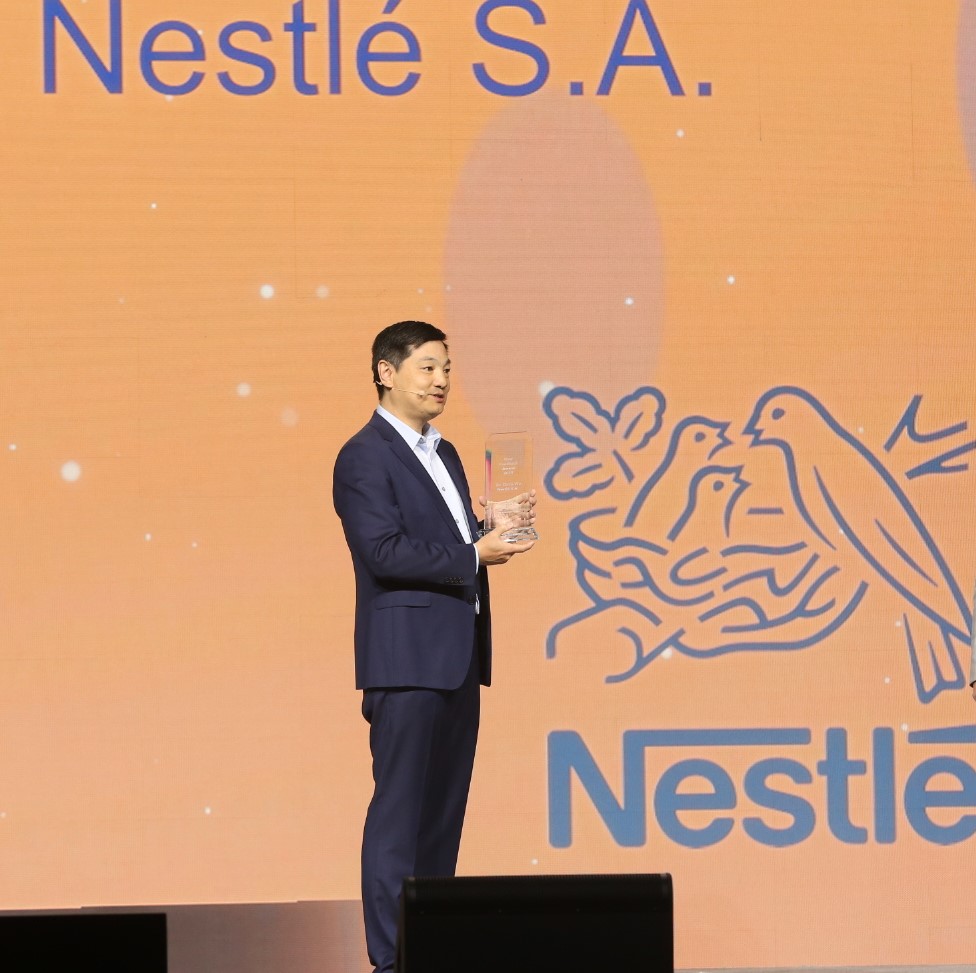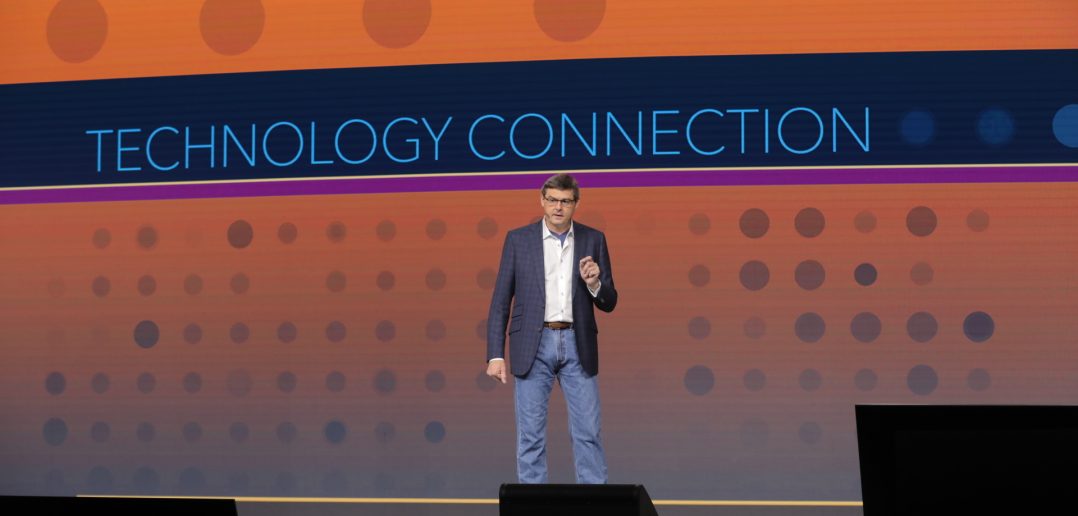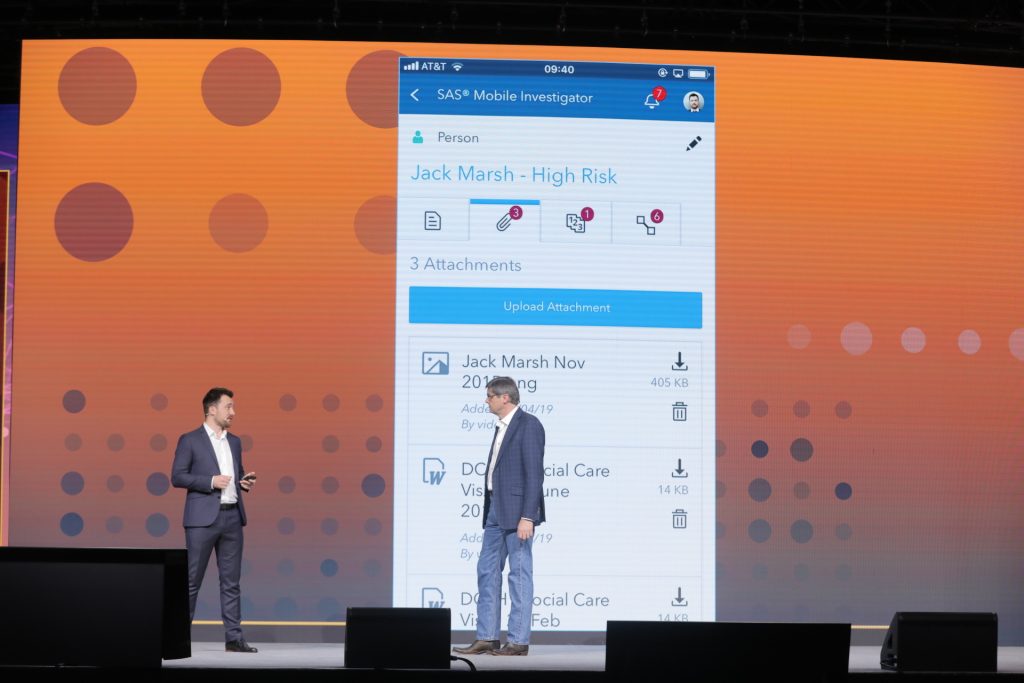Artificial intelligence is the attention-grabbing, overhyped, shiny object that every organization is searching to make use of.
Yes, it is overhyped, but it’s also very real and very powerful.

“We do not want to add to the hype. We do not want to add to the confusion. We want to make analytics, machine learning and artificial intelligence real. We want to bring it to life,” said Executive Vice President, Chief Operating Officer and Chief Technology Officer Oliver Schabenberger.
That’s exactly what he – and many SAS customers – did during this year’s Technology Connection session at SAS® Global Forum. By putting analytics in action, we gave attendees a front-row seat to how some of the biggest problems in the world are being solved with data, analytics and SAS® technology.
And those ninety minutes of innovative, analytically-powered discoveries showed the range of practical applications SAS technology has, from fighting cancer to fighting fraud.
“We want to innovate to meet your needs, and we want to empower you to innovate with our products,” said Schabenberger. “Organizations are learning the power of analytics, and we are learning about their needs and applications.”
Here’s a look at the some of the ways customers are putting analytics into action:
Customer driven innovation – transforming health care with computer vision
Working together, we can generate value for the organization and for its constituents and customers. It’s especially rewarding when that collaboration has a positive effect on lives—affects them, maybe improves them, maybe even saves them. Analytics is an opportunity and a necessity in the transformation of health care.
Two years ago, SAS partnered with Amsterdam University Medical Center to use computer vision and predictive analytics to improve care for cancer patients. Dr. Geert Kazemier, Professor of Surgery and Director of Surgical Oncology at the Amsterdam University Medical Center shared that colorectal cancer is the third most common type of cancer worldwide, with metastasis occurring in about half of these patients.
This level of patient-specific geometry in medical images was not available before using SAS computer vision. The results can help tailor cancer treatments for individual patients at Amsterdam UMC.
Watching live demo now at #SASGF >> Using #AI to detect cancer using 3D medical imaging with #ComputerVision in SAS Viya and SAS Cloud Analytics Services: https://t.co/oMPG7xjh4B by @SASsoftware #BigData #DataScience #MachineLearning #NeuralNetworks pic.twitter.com/7QSYlofxoO
— Kirk Borne (@KirkDBorne) April 29, 2019
The application can capture highly detailed 3D geometries of liver and lesions from the data provided by Amsterdam UMC. This level of patient-specific geometry in medical images was not available before using SAS computer vision. The results can help tailor cancer treatments for individual patients at Amsterdam UMC.
Additionally, SAS Viya supports applications that can almost fully automatically go from raw images to objective metrics that may be used in the clinic. Such automation will save radiologists a lot of time. And, it provides an objective response assessment metric that will help radiologists treat patients consistently.
Machine learning - interpretability and bias
Xin Hunt, SAS software developer in AI and Machine Learning R&D, joined Schabenberger to discuss and demonstrate model interpretability and bias as it relates to lesion detection and general image processing. She demonstrated how giving clinicians assistance using AI and natural language generation to automate the decision making process leads to faster, more reliable decisions.
Automated machine learning pipeline
But, what if we could use the historical data to develop a machine learning model to predict a risk score for each child? That score can accompany the alert and helps the social worker to prioritize visits and follow-ups.
How can we automate the modeling and deployment steps and derive a model we feel good about — a model we can trust?
Children are paying the price for the opioid epidemic in America. Having vital information quickly can save a child's life. #data4good #SASGF https://t.co/gf9mbrtafi pic.twitter.com/KrePIPEJIY
— SAS Software (@SASsoftware) April 29, 2019
SAS Mobile Investigator – from the lab to the field
Moving out of the lab where machine learning is used to detect and flag children who are potentially at high risk of abuse or mistreatment, Sebastien Charrot, SAS Senior Manager of the Scottish R&D team, explained how to use that data in the field.
SAS has a powerful suite of tools which allow organizations to triage their alerts, manage their intelligence, and coordinate the investigations that follow. Until now however, those capabilities were limited to users in the office or station. To combat this, SAS recently launched SAS Mobile Investigator: a mobile application which surfaces the operational and investigative power of Viya, to users in the field.
For example, a police officer working in the child protection unit may have a responsibility to liaise with social workers, visit certain at-risk children, assess their situation, and take any necessary action. The job of police officers is changing -- officers are expected to maximize their time in the field by picking up their previous desk-bound tasks on their mobile devices.
Using SAS Mobile Investigator, an office can analyze documents uploaded and associated with this case while en route to the home – including previous social worker visits, parental firearm possession, criminal records, school incidents, neighborhood search for intelligence of interest, and other factors that could impact the visit and assessment. Having this information in the field ahead of time can save lives.
“For the first time, we have placed the power of SAS Viya into the hands of operational users, allowing them access to data and analytics wherever they are. The users can spend more time in the field, are better informed, better equipped, and can do their job more effectively. It is about automating the obvious, time-consuming, and possibly error-prone tasks,” summed up Schabenberger.
Analytics in action – hidden in plain sight
Technology is unstoppable, it’s who we are, it’s what we do. Not just at SAS — but as a species.
Technology are all the inventions of the human mind, not just tools and gadgets.
Analytics, the multi-disciplinary effort to derive insight from data, is also technology. And as such, it exhibits the same urgencies as all technology: It wants to reorganize, become more distributed, abundant, and accessible.
Tech Connection demonstrated how these organizing principles manifest themselves:
- Enabling insight and decisioning based on data by those without degrees in data science.
- Jobs made easier, more productive.
- Decisions made more reliably and faster by increasing access to analytics.
- Analytics that follows the data. It becomes more distributed and is applied by the right person at the right place and time.
- Analytics moves from science projects into operations — the hospital, the department of social services, the field engineer and police officer.
At SAS, we are on a mission to remove barriers to producing and to consuming analytics.
- Through visual interfaces at parity with programming interfaces.
- Through open source integration.
- Through APIs that make building and deploying models simpler.
- Through automation of analytics.
- Through embedding analytics.
Machine learning models in one click. Susan and Dragos are the developers who made it possible. #SASGF pic.twitter.com/YqewwM1Xhk
— SAS Software (@SASsoftware) April 29, 2019
User Feedback Award Winner

SAS innovation is customer-driven: innovate to meet our customer’s need and create tools and solutions that help our customers innovate. For this to work we have to communicate, talk to each other, learn from each other. Exchange openly what works and what doesn’t.
The winner of this year’s User Feedback Award exemplifies the conference theme of ‘Analytics in Action.’ Dr. Davis Wu of Nestle is a visionary in examining ways that artificial intelligence and machine learning can be used for demand forecasting and planning capabilities.
He provided input that resulted in the creation of a new demand capability – Assisted Demand Planning – that uses machine learning to boost forecast value added. He has shared ways that his company is using SAS Forecast Server and SAS Demand-Driven Planning and Optimization.
He has also engaged with Product Management at SAS to discuss functional requirements for the upcoming SAS Visual Demand Planning Solution on SAS Viya.


